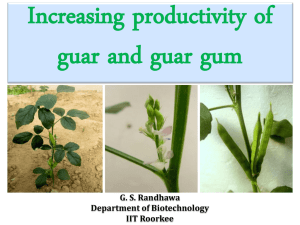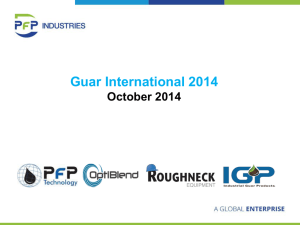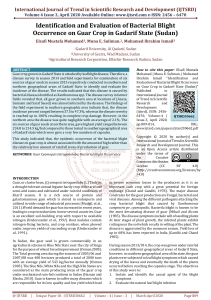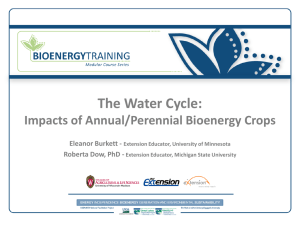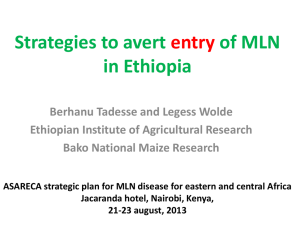5.5 Guar (Cluster Bean) - Spate Irrigation Network
advertisement
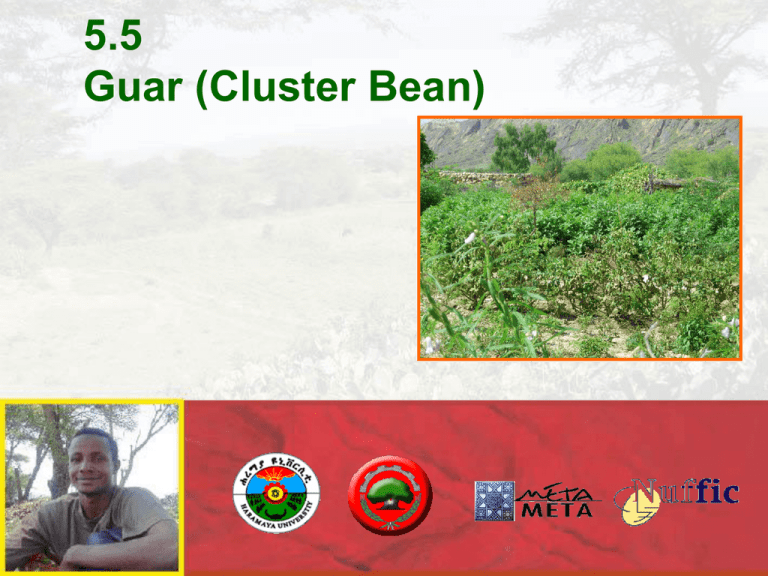
5.5 Guar (Cluster Bean) GUAR: forgotten crop growing in most marginal conditions many modern applications Guar - Introduction Guar is a drought tolerant annual legume that grows in hot, semiarid regions with sandy soils The major world suppliers are India, Pakistan, the United States and smaller acreages in Australia and Africa The world demand for Guar increased which lead to introduction of Guar in other countries Guar - Crop properties Guar is an upright course-growing summer annual legume (18-40 inches) (45-100 cm) The deep roots reach deep moisture Leaves, stem and pods are smooth The Guar bean has a large endosperm The endosperm contains large amounts of gum which is the marketable product of the plant Guar – Some examples of use The gum of Guar forms hydrates rapidly in water into a viscous gel and is therefore used in various products In Asia: Beans for vegetable consumption Crop for cattle feed As green manure In the United States: No calorie binding agent • fi stiffener in soft ice cream In pharmaceutical industry In cloth and paper manufacture Oil well drilling muds Guar – climate and soil Drought resistant High toleration of temperature (77 to 95˚F) (25 to 35˚C) Grows well under a wide range of soil conditions, but preferably fertile, medium textured and sandy loam soils Salinity and alkalinity tolerant Soil improving crop Fits in crop rotation program (with grain sorghum, small grains or vegetables) Cultivation - Seed preparation Select seeds with same size and colour Selected seed must be free from other crop and weed seed Select seed from the most recent varieties (New varieties are more resistant to diseases) Inoculate the seed before planting with a special guar inoculant (or a cowpea inoculant) Plant the seeds in moist soil within 2 hours after inoculation The seed bed should be free of weed Cultivation – Seeding date Plant Guar when soil temperature is over 70˚F (21°C) Optimum temperature for germination is 86˚F (30°C) Essential conditions: Warm seedbed Adequate soil moisture Warm growing weather Cultivation – Seeding and fertility With row crop planter, Guar can be planted in rows from 36 to 40 inches. (90-100 cm) Planting depth of 1 to 1.5 inches deep (2.5-4 cm) Guar requires a high level of phosphorous (22 to 34 kg of P2O5/ha) and a medium level of potash (45 to 56 lb of K2O/ha) Apply fertilizer before planting and below the seed Optimum pH value is between pH 7 an pH 8 Guar varieties in USA Brooks; (1964); first improved variety. High yielding and resistant to major diseases. Hall; later maturing compared to Brooks. Resistant to bacterial blight and Alternaria leaf spot. Best adapted to heavier soil types and higher elevation. Mills; Early maturing and also resistant to bacterial blight and Alternaria leaf spot. Lower yields than Hall and Brooks. Kinman; (1975) a week earlier in maturity than Hall. Highly resistant to bacterial blight and Alternaria leaf spot. Esser; (1975) medium to late in maturity. Better disease tolerance than Brooks. Lewis: (1986) Medium to late maturing. Seed yields are approximately 25% higher than Kinman. Control Measures Weed control Because of the slow growing rate of young Guar plant, weed control is important Mechanical control: Do not seed Guar in fields with Johnson grass and other perennial weeds Early land preparation minimizes weed problems Chemical control: Treflan (selective herbicide) can be used to control annual grasses and annual broadleaf weeds Diseases control Select disease-resistant varieties and high quality certified seed to prevent Guar from Alternaria leaf spot (fungal disease) and Bacterial blight (seed-borne disease causing plant losses) Control of insects and other predators Guar Midge is the primary insect pest in the Southwest of the USA. Rainfall or sprinkler irrigation may reduce the midge population Harvesting Seed pods are brown and dry at maturity To speed up drying and to kill weeds, Gramoxone (paraquat) can be used Guar beans can be harvested with a normal grain combine To clean out foreign materials use a high fan speed Reels should be set deep enough in the Guar to control stalks (15 to 30 cm ahead of the cutterbar) For hay: cut crop when first pods turn brown For green manure: Guar should be turned under when lower pods turn brown For seeds: after harvesting Guar can be used as mulch when it is plowed under After harvesting Income and production costs vary every year and are also depending on soil types Yields vary from 55 to 360 kg per hectare Production costs are between 8 and 16 USD/hectare. (depends on fertilizer usage and other production practices Situation in Pakistan Guar is poor man’s crop Only a few guar gum processing plants – that are struggling to survive Quality issues Guar processing needs revival and international marketing effort! Sources of Pictures Sheet 1 – www.niemagazine.com Sheet 2 - www.plthomas.com/guar.html Sheet 3 - juniper.tamu.edu/Agronomy/guar_pods.htm Sheet 4 - http://www.shreevinayakcorp.com/guar-gum.html Sheet 8 - http://www.guar-tex.com/images/seed.jpg Sheet 12 - http://milksci.unizar.es/bioquimica/temas/azucares/ auxiazucar/cyamopsis.jpg
